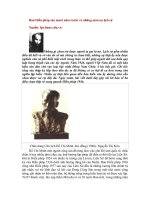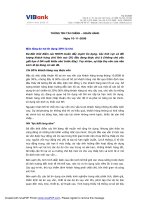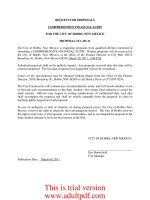Jake Bernstein no bull investing_1 pptx
Bạn đang xem bản rút gọn của tài liệu. Xem và tải ngay bản đầy đủ của tài liệu tại đây (263.1 KB, 23 trang )
This publication is designed to provide accurate and authoritative information in
regard to the subject matter covered. It is sold with the understanding that the
publisher is not engaged in rendering legal, accounting, or other professional ser-
vice. If legal advice or other expert assistance is required, the services of a com-
petent professional person should be sought.
Vice President and Publisher: Cynthia A. Zigmund
Senior Managing Editor: Jack Kiburz
Interior Design: Lucy Jenkins
Cover Design: Design Alliance, Inc.
Typesetting: the dotted i
© 2003 by Jacob Bernstein
Published by Dearborn Trade Publishing
A Kaplan Professional Company
All rights reserved. The text of this publication, or any part thereof, may not
be reproduced in any manner whatsoever without written permission from the
publisher.
Printed in the United States of America
03 04 05 06 07 10 987654321
Library of Congress Cataloging-in-Publication Data
Bernstein, Jacob, 1946-
No bull investing : straightforward advice to maximize your returns in
any market, with any amount of money / Jake Bernstein.
p. cm.
Includes index.
ISBN 0-7931-6274-2 (6x9 paperback)
1. Investments. 2. Finance, Personal. I. Title.
HG4521.B4443 2003
332.6—dc21
2003001186
Dearborn Trade books are available at special quantity discounts to use for sales
promotions, employee premiums, or educational purposes. Please call our Special
Sales Department to order or for more information, at 800-621-9621, ext. 4404, or
ii NO BULL INVESTING
C ONTENTS
Acknowledgments vi
Introduction vii
PART ONE PREPARATIONS
1. WANT TO MAKE MORE MONEY? DO THESE THINGS FIRST 1
Who Am I? 4
A Few of the Things I Learned and Why I Want to Share Them with You 9
2. BEGINNINGS, DANGERS, AND DIRECTIONS 19
Of Course You Want to Take Immediate Action! 20
The Dangers of Moving Too Slowly 21
Do It Alone or Get a Partner? 22
A Checklist for Successful Preparation 23
3. MARRIAGE, MONEY, AND FAMILY 33
Investing and Marriage Issues 33
Harnessing the Synergism of a Two-Income Family 34
Life Insurance on Both Partners: Term, Convertible Term, or Other 35
Tax Considerations and Strategies 37
Planning for the Financial Burden of Having Children 38
Protecting Your Assets from Legal Ramifications 40
You and Your Spouse as Investment Partners 42
4. SELF-KNOWLEDGE: Your Practical and Emotional Selves 45
Investor Behavior 46
Mastering the Psychological Aspects of Investing 50
The Majority Is Usually Wrong—Don’t Forget That! 53
5. SETTING FINANCIAL GOALS 55
Many Investors Have Been Losers 58
iii
Victims of the System 63
A Few General Rules to Get You Started 64
The “Boring” Part of Setting Financial Goals 73
PART T WO
STRATEGIES AND ALTERNATIVES
6. THE GENERAL INVESTMENT MODEL 81
An Overview of the General Investment Model (GIM) 81
The Setup, Trigger, and Follow-Through Method (STF) 92
The STF in Detail 96
Summary 99
7. THE METHOD 101
Selection and Timing of Investments 102
Introducing the Method 106
Introducing Momentum 109
How to Calculate Momentum 111
What Does Momentum Tell Us about a Market? 112
Divergence and Changes in Trend 113
Timing, Timing, Timing 117
Where Do I Get the MOM? 120
Practice, Practice, Practice! 120
8. GAMBLE OR INVEST YOUR WAY TO WEALTH? 129
The Instant Age 132
Contradictions, Conflicts, and Consistency 132
Narrowing the Field of Choices 133
How the Stock Market Can Be a Gamble 137
How the Stock Market Can Be an Investment 138
How the Stock Market Can Be Used for Trading 138
Real Estate and the General Investment Model 139
The Good News and the Bad News in Futures Trading 140
9. STRATEGIES FOR A SHOESTRING BUDGET 143
The Three Shoestring-Budget Starting Levels 145
$5,000 Available Starting Capital 146
How Dollar Cost Averaging Works 146
Drip Your Way to Success 151
iv C ONTENTS
Less Than $2,500 Available Starting Capital 151
A Few Portfolio Suggestions for Beginners and Small Investors 154
10. GETTING SERIOUS: Strategies Beyond the Shoestring Budget 157
From $5,000 to $20,000 157
More Than $10,000 but Less Than $25,000 158
More Than $25,000 but Less Than $50,000 159
More Than $50,000 159
Investing in Precious Metals and Coins 159
Protecting Yourself with Investments in Rare Coins 162
Numismatics and Numismatic Coin Investment Programs 168
Guidelines for Investing in Coins 170
Fast and Furious—The Hottest Games in Town 172
PART THREE LOOKING AHEAD
11. STAYING AHEAD OF THE CURVE: Emerging Opportunities 177
What’s Ahead in the Area of Technological Breakthroughs? 178
12. SUMMARY AND FINAL THOUGHTS 181
A Perspective on Investor Psychology 181
Economic Yin and Yang: Cycles of Boom and Bust 187
Markets Have a Life of Their Own 191
Yesterday, Today, and Tomorrow 192
Summing Up the Lessons Learned 194
Keep in Touch 194
Appendix: Practice Charts and Analyses 195
Online Resources 207
Index 209
C ONTENTS v
A CKNOWLEDGMENTS
I wish to thank the following individuals and organizations
whose assistance was instrumental in the preparation of this book:
• Don Hull, former editorial director at Dearborn Trade Pub-
lishing, who had the faith and foresight to take me on as
an author and who displayed remarkable restraint in spite
of my tardiness.
• Jack Kiburz, senior managing editor, who did a magnifi-
cent job with my manuscript, turning a rough and disor-
ganized effort into a book that expresses my ideas clearly
and correctly.
• My family, in particular my wife Linda, without whose tol-
erance and support I would not have been able to complete
this work.
• Mark Shriver and Glen Larson at Genesis Financial Data
for permission to use their charts and indicators.
• CQG Inc. for permission to use their charts and indicators.
• My office staff, in particular my associate Marilyn Kinney,
who has for more than 27 years with me developed a unique
and effective understanding of my needs, quirks, and tem-
perament as an author.
• And finally, Judith Marie Richards, who spent many hours
editing my work before I ventured to send it off to Dear-
born for editing and input.
vi
INTRODUCTION
Congratulations! I commend you for buying this book. If you
have borrowed this book from a library or a friend, then I com-
mend you for being frugal. Saving money is a good thing to do.
Perhaps, after you read this book and realize that it offers you
many important tips, tools, strategies, and directions for finan-
cial success and survival, you may want to buy a copy for yourself
and make it a permanent part of your investment resources.
I congratulate you, simply because there are few individuals
who are willing to take the time and effort to become financially
independent. Most people today are looking for easy answers,
easy success, instant success, get-rich-quick schemes, the lot-
tery, and that windfall inheritance from Uncle Louie. The fact
that you have taken the time and the trouble to seek out this
book—and hopefully to learn from it and use it—sets you apart
immediately from the millions who dream of success but who
don’t have the self-control or discipline to do anything but
dream.
The fact that you actively explore your possibilities is a very
positive feature of your personality—and therefore I commend
you. But what’s next? Now that you’ve decided to read this book,
what can you expect? What will this book do for you? Here are
some things to consider. If you’re in a bookstore as you read
these words, then don’t even think about buying this book un-
less you are willing to take the following three steps:
vii
1. Read and study this book. Underlining or highlighting the
important points that I have made will help you with the
next step.
2. Make a commitment. Even if it’s a small one, commit to put
into action one or more of the ideas in this book, if they
appeal to you. Remember that book learning is one thing,
and action is yet another thing. Learning for the sake of
learning is fine if you’re interested only in academics;
however, action is what separates those who succeed from
those who only dream of success. And finally . . .
3. Be consistent. If you’re the kind of person who reads a few
pages of a book and then puts the book away, promising
to come back to it later, then do yourself a favor and ei-
ther promise yourself to read this book from cover to
cover or put this book down and don’t waste your time
and money. This book is all about ACTION. If you’re
PROACTIVE, or want to be, then this is THE BOOK for
you. If you’re inconsistent, unmotivated, or erroneously
believe that success will come to you automatically, forget
about this book.
Yes, my opening statements may seem somewhat harsh and
direct. But my aim is not to alienate you—not at all. I’m only in-
terested in reaching people who have a burning desire for suc-
cess. These are the people who will most benefit from this book.
And hopefully, their success will prove to be an inspiration to
those who presently may be only dreamers.
So, read my book, take my advice seriously, test the waters,
and don’t let yet another opportunity pass you by. If you do,
you’ll be old and gray, wondering why you failed to take action
when you had so many opportunities. Seize the moment, learn
your lessons, and go forward with success!
viii INTRODUCTION
CHAPTER ONE
WANT TO MAKE
MORE MONEY?
DO THESE THINGS FIRST
Are you tired of seeing your hard-earned dollars buy you less
and less? Are you tired of scrimping and saving to make ends
meet? Does your paycheck disappear the minute it goes into the
bank? Do you want to make more money? Are you envious of
others who ARE making good money in their investments? Are
you frustrated because you feel that you don’t have the tools to
make money? Do you believe that in order to make money as an
investor, you will need special skills that can only be acquired in
college or through a long course of study? Do you believe that
you need a “good broker” in order to make money in the stock
market? Do you believe that you need a good real estate broker
to make money in real estate? The response to most of these
questions is “No.” The facts are simple:
Ⅲ You don’t need to be like the millions of people who
merely get by, living from paycheck to paycheck.
1
Ⅲ You don’t need a college degree in finance in order to
make money in the stock market; in fact, having such a de-
gree might be detrimental to your success.
Ⅲ You don’t need a good real estate broker in order to make
money in the real estate market.
Ⅲ You don’t need to spend hours of research in order to
make money in stocks.
Ⅲ You CAN get the tools you need to become a successful
investor.
This book will give you almost everything you need to be a
successful investor. All you have to do is to make the commit-
ment and follow through on it. You bought this book in order
to make money. So use this book and follow through, or you will
have wasted your hard-earned money. Begin on the right foot-
ing, be consistent, and you will be more likely to succeed.
This chapter will tear down many of the misconceptions you
may have about investing as a way to become financially inde-
pendent. I will replace any distorted ideas you may have with
ones that have not been “polluted” by traditional investment ad-
visors who seek to make you dependent on their advice. You will
become your own expert, if you so desire. Will the process be
painless? Will success just fall into your lap? Will you merely
wake up one morning with newfound wealth? The answer to
these questions is “No.” However, if you make the effort, you will
increase your chances of success, and you will learn skills to
serve you well for a lifetime.
The American dream of going from rags to riches has been
more than just a dream to hundreds of thousands of people dur-
ing the 20th century. Today, in spite of the economic slowdown
and stock market decline that started in late 1999 and 2000,
2 NO BULL INVESTING
there are more wealthy people in the United States than ever
before. It is a simple fact that our economic system rewards hard
work, creativity, motivation, entrepreneurship, self-sufficiency,
and ingenuity. In spite of a tax structure that often limits the at-
tainment of wealth and the operation of a successful business,
millions of Americans are able to achieve high levels of success.
The doors to success are open to everyone, no matter what
their educational level, race, creed, color, or religion may be.
While it is sadly true that minorities and women are still discrim-
inated against, it is also true that they have more opportunities
for success than ever before. Whether you are a Harvard Law
School graduate from a wealthy family or an individual who was
raised in the inner city without access to quality education, you
can achieve wealth. Although success does indeed depend some-
what on social status, education, political connections, and fam-
ily wealth, these are not always prerequisites.
Many self-made millionaires have started with virtually no edu-
cation, no money, no family influence, no political connections,
and no assistance. These individuals have made their fortunes
based on an idea, on talent, on motivation, on hard work, on
persistence, and on the burning desire to rise above their status.
The good news is that there are many ways in which wealth
can be achieved in America. The bad news is that the individual
who is not blessed with talent to sing or act or play professional
sports, or who possesses superb intelligence and a college edu-
cation in medicine, engineering, law, or science, is often at a dis-
tinct disadvantage. There are few vehicles they can use to take
them to their goals. This book is about those vehicles. It will help
you find the means to achieve your goal of wealth if you are one
of the millions who were not blessed with unique skills or tal-
ents, family money, or political connections.
Finally, even though there are many avenues for success in a
free economy, some methods are more easily implemented than
WANT TO MAKE MORE MONEY? DO THESE THINGS FIRST 3
others. Some require less work, and some require less start-up
capital. Although I will introduce you to a number of ways in
which you can achieve success and financial independence, I will
not leave you guessing as to which ones give you the best odds.
WHO AM I?
By now you may be thinking, Who is this guy and why should
I listen to him? These are reasonable questions, so let me give
you a few reasonable answers. Without going into agonizing de-
tail, suffice it to say that I was raised in a very poor family. I was
born in Europe to parents who had been in Nazi concentration
camps. My family came to Montreal, Canada, with literally noth-
ing but the clothes on our backs and a few suitcases of personal
items. We were taken in by a family who rented us one room in
their house. My mother, father, sister, and I shared that one
room. My parents worked many hours a day just to pay the rent
and put food on the table.
The neighborhood in which I was raised was populated by
French Canadian street gangs, ethnic minorities of various types,
crime, filth, and failure. My performance in school was pathetic;
I barely made passing grades. My father was a piecework tailor
working in a clothing factory for many years, and my mother was
a seamstress. Getting to and from school each day was like pass-
ing through a combat zone. I was often chased and taunted or
beaten by gang members. Stealing, fighting, drugs, and other
types of crime were rampant. If you were big and strong, mean,
and a good fighter, then you were “successful.” If you were short
and meek, underweight, and undernourished, like I was, then
you were a “failure.”
Clearly, the law of the jungle ruled on the mean streets of
Montreal. Education was frowned on by the gangs and by my
4 NO BULL INVESTING
peers. School was an evil necessity. The educational system did
little to encourage creativity or achievement. School was dull,
and the teachers were generally frustrated, underpaid, boring,
and punitive. Corporal punishment was condoned, indeed en-
couraged, and enforced. Minor violations of the rules were
often responded to with beatings by the school principal as well
as by parents. What was standard procedure then is today con-
sidered child abuse.
By law, students who failed to achieve passing grades by the
first few terms in high school were sent to vocational schools to
learn carpentry, automotive repair, electrical work, construc-
tion, or other trades. The system did not reward effort; it merely
perpetuated the success of those who were innately intelligent
and beat down those who were either unmotivated but intelli-
gent or who were average or below average in intelligence. In
short, the system was an abysmal failure.
Understandably, I struggled and suffered, and by age 13, I
was told I had no future other than to be a shoemaker or a ditch-
digger. The fate of many of my friends would be similar to mine,
unless of course they chose crime as a means to achieve success.
Some of them did exactly that. Some became street bums, and
others died violent deaths at the hands of street gangs. Fortu-
nately, I escaped just in the nick of time.
Through a fortunate twist of fate, my family was given the
opportunity to move to the Chicago area. We left the slums and
started a new life. My father opened a tailor shop, and my mother,
whose skills as a seamstress and dress designer in Canada were
only minimally rewarded, did much better in the United States.
Although we were not wealthy by any stretch of the imagi-
nation, we did manage to buy a home, a car, and other “creature
comforts” that made life more livable. Getting enough food and
clothing was no longer an issue for me. And I was no longer afraid
of being beaten, tortured, or killed by street gangs. I could walk
WANT TO MAKE MORE MONEY? DO THESE THINGS FIRST 5
to school without looking over my shoulder to see if I was about
to be attacked. Life was better in many ways, but I quickly dis-
covered the myriad social games that children and adults play in
upper-middle-class America.
These games were totally new to me; I knew nothing about
the rules of engagement. All I knew was that I was surrounded by
wealth and game players, and although the wealth impressed me,
the social games sickened me. I had few friends. After all, what per-
son of high class would want to associate with the son of a mere
tailor and a seamstress? Still, I managed to make a few friends. In
so doing, I discovered that most of the people living in Chicago’s
northern suburbs had either inherited their money or had made
it in the stock market. I discovered that there were opportunities
in this country that far surpassed anything I could have achieved
in the Montreal ghetto. I learned that even those of average or
below-average intelligence had a fighting chance in America. I
began to realize that the American dream could be my reality.
I watched my parents work 12 to 14 hours a day, seven days
a week in order to make ends meet. They supported my sister
and me through college and eventually retired to Florida, where
they lived out their remaining days before they both died fairly
young. By then I was married, had several children, as well as a
home, several cars, and many of the things I did not have as a
child. I was bound and determined not to follow in my parents’
footsteps. Yet, by education I was limited in how much I could
earn. In college, I studied clinical psychology. Figuring how much
I could earn when I became a full-fledged psychologist, I realized
that my potential was limited by the number of patients I could
see in one day. Yet, it wasn’t a purely moneymaking proposition
for me; I had the true and sincere desire to help people.
Not blessed with a wealthy family or a business I could take
over from my father or mother, I had to strike out in a new and
uncharted direction. Seeking to make my fortune and my mark
6 NO BULL INVESTING
in an area that was completely different from clinical psychol-
ogy, I turned to the financial markets because of the limited ex-
posure I had to stock trading in college.
My roommate John at the University of Illinois was an avid
stock market investor. Although he was still very young, he had
learned the basics of investing and trading from his father, a sur-
vivor of the Great Depression and the stock market crash of
1929, as well as many up and down markets since.
John was a very intelligent young man and took to the stock
market with all of his energy. He researched stocks, studied mar-
ket trends, charts, earnings, new products, and stock market be-
havior. He read the Wall Street Journal, Barron’s Financial Weekly, the
Wall Street Transcript, the Journal of Commerce, and many other pub-
lications that provided in-depth information about the financial
markets. In short, he was a true market scholar with a thirst not
only for profits but also for the knowledge that could be acquired.
He approached the markets as a challenge and sought to solve the
deep mystery of market behavior. But there was a problem: he was
too young to open a trading account. And that’s where I came in.
I was two years older than John, so he convinced me I ought
to open an account at the local Hayden-Stone brokerage office
in Champaign, Illinois. He offered to fund the account and teach
me about the markets, if I made trades for him. As I recall, we
also agreed to split the profits, if any, from our venture.
Our first foray into the market was a low-priced Canadian
gold mining stock, Wright-Hargreaves, whose ticker symbol at
that time was WRT. As I recall, WRT was trading at about $3 per
share. We had high hopes for the stock, because it was a gold
mining stock and therefore likely to go higher if inflation or po-
litical unrest became factors in the U.S. and world economies.
Virtually every day, we would venture to the brokerage office to
watch the ticker on their large quotation board. We were hyp-
notized by the tape, watching the numbers change.
WANT TO MAKE MORE MONEY? DO THESE THINGS FIRST 7
We cheered mentally with every price change in WRT: WRT
3 1/16 . . . 3 1/8 . . . 3 3/16. We had visions of great wealth. Of
course, WRT didn’t make us rich, but the lessons we learned
have served us well. From WRT we ventured into other gold
mining shares. We studied the South African and Canadian gold
companies. We graduated into mobile home stocks, such as De-
troit Mobile Home and Fleetwood Enterprises. John was cor-
rectly convinced that semiconductor stocks would become big
winners in the years ahead.
John encouraged me to read books about the stock market,
and I did. To date, the single best book I read was Reminiscences
of a Stock Operator by Edwin Lefèvre (alias Jesse Livermore). This
was one of John’s favorite books, and it became one of mine.
Today, I own several copies, including one of the original copies
from the 1930s. It is a book that I encourage every individual to
read, whether he or she is interested in the stock market or not.
Why? Because it contains numerous life lessons about human
behavior and psychology. These valuable principles are applica-
ble not only to investing but also to business in general and to
daily life.
After learning about stocks from John, I ventured off into
commodity trading. John and his father were convinced that
this would be my ruin. The commodities market was a wild and
woolly place in the 1960s, as, to a given extent, it is today. Com-
modity trading (called futures trading today), was like the Wild
West of the investment scene back then. The moves were fast
and furious. You could lose all your investment capital in a mat-
ter of minutes. But you could make a large amount of money
quickly as well, although not as easily.
I was lured into the commodity market by a fast-talking Chi-
cago broker who convinced me to send him $1,000. For those
who don’t remember economic history, $1,000 in the late 1960s
would be the equivalent of $16,000 in the 2000s. A new Volks-
8 NO BULL INVESTING
wagen Beetle cost about $1,600. It wasn’t easy for me to part
with the money; however, I did so because I was lured by the
prospect of making big money. After all, the broker virtually
guaranteed me that I could make $18,000 that year, and I was
not pleased with my earning prospects in the field of psychol-
ogy. Because my father was a hardworking tailor who rarely
earned more than $5,000 a year in his business, the prospect of
earning $18,000 a year or more was very attractive.
My venture, or more correctly my adventure, into the com-
modity markets was a mixed blessing. At first, I was a winner, and
then I was a loser. It’s a story all too frequently repeated in the
commodity markets. But the good news was that I learned a
great deal, not only about trading but also about myself. My ex-
periences led me to do research on market behavior in stocks
and commodities as well as in economic trends.
Through my research, I learned a number of valuable con-
cepts that have served me well now for many years. I will share
these with you, because I truly believe that these lessons will
help you achieve your goal of financial independence, no mat-
ter how old you are, which markets or businesses you plan to go
into, and what your level of experience may be as an investor.
I believe these concepts as well as their methods of applica-
tion can be your keys to success, even if you begin with a very
small amount of capital. I also believe that these concepts and
methods can help anyone achieve the American dream, no mat-
ter the level of education, social status, and current profession.
A FEW OF THE THINGS I LEARNED AND
WHY I WANT TO SHARE THEM WITH YOU
My experiences have taught me valuable lessons that everyone
who wants to achieve financial independence should know and
WANT TO MAKE MORE MONEY? DO THESE THINGS FIRST 9
take to heart. Although some of the lessons may not seem espe-
cially relevant to you at this time, I assure you they will become
important to you when you realize that the good life in a capi-
talist society is a pure function of money and success. Now I am
not, in any way, shape, or form, suggesting that everything
revolves around money. Clearly, it does not. Family, friends, spir-
ituality, social awareness and action, as well as ethics and commit-
ment are all part and parcel of a balanced and well-integrated
personality. But these are outside the scope of this book. Re-
member: No matter how much success you may achieve finan-
cially, your gains will amount to nothing if you fail to develop
other important aspects of your life.
There are several reasons I want to share these things with
you. First and foremost, I believe that every individual who lives
in a democratic, capitalist society is entitled to share in the
progress and wealth that defines such societies. Although we will
not all be fabulously wealthy, we are all capable of living very
comfortably if we set our minds and actions to success.
Second, and of considerable importance to me, I want to give
back to society some of what it has given to me. In other words,
I want to offer thousands of individuals, perhaps hundreds of
thousands, the opportunity to be successful using the tools that
took me many years to accumulate. And third, I want to know that
I have made an impact, that I have made my mark on society, and
that I have hopefully helped improve the lives of many people.
Not too long ago, I received a complaint by e-mail from a
woman who had read a book I coauthored with my son, Elliott
Bernstein, titled Stock Market Strategies That Work (McGraw-Hill
Professional, 2002). She told me there were some errors in the
book. I asked her what the errors were and, on receiving her
reply, I sent a thorough response to her questions, as well as a
detailed response to questions she asked that were not part of
the book she had read.
10 NO BULL INVESTING
She wrote back, telling me that she was still upset about the
errors she found and that she wanted to return the book. Rather
than thank me even once for the knowledge the book gave her,
she was intent on complaining about the $19.95 she had spent.
I replied again, telling her that she ought to return the book if
she was so totally dissatisfied, and that I would still be willing to
help her with any questions she had free of charge. My interest was
purely to assist her. I did not, as some individuals in my profes-
sion do, tell her that my consultation fee was $500 per hour or
that she needed an appointment.
Still, she focused her energies on complaints rather than so-
lutions. She implied that my purpose in writing books was to
make money and not to educate. Apparently, she did not under-
stand that writing books like this one generally yields only a small
amount of money for the author, and that the book would likely
sink into obscurity after a year or two. Let me tell you again that
my goals are first and foremost to educate and to have an impact
on society, hopefully to improve the lot of average individuals.
My lessons in the stock and commodity markets taught me a
number of basic but highly important facts.
Patterns Are the Key to Success in
Virtually Any Business or Investment
By this I mean that history repeats itself not only in the mar-
kets and in economies but also in business ventures. All things
in life follow cyclical patterns. Cycles begin at a low point, rise
to a peak, and then decline, only to repeat the process. Think
of your own life and experiences in this context. Think about
your successes and failures. Think about your relationships. I
will elaborate on this highly important fact of life repeatedly
throughout this book. For now, take my word that life is full of
WANT TO MAKE MORE MONEY? DO THESE THINGS FIRST 11
patterns, and that if we know the patterns—of life, of investing,
and of economics—then we have improved our odds of success
substantially.
Time Is More Important Than Price
We are all preoccupied with price. We bargain for lower prices,
even though we want to buy a given item. Sometimes, we miss the
opportunity to buy or sell because we waited for a certain price.
Though well-to-do in their own right, my in-laws will travel nine
miles to buy grapes for ten cents a pound less than they can buy
them locally.
Investors who were bitten by the gold bug in the 1970s be-
lieved the Hunt brothers when they predicted gold would rise to
$1,000/oz. and silver to $100/oz. They bought at the right time,
but today, over 25 years later, they’re still waiting for the markets
to hit these predicted price targets. Their mistake was that they
were thinking in terms of price and not in terms of time. If the
time was right to exit gold and silver, then what did it matter
if the price was right? Hundreds, if not thousands, of investors
thought if United Airlines had declined from over $100 per share
in 1997 to $20 per share in 2002, that it was dirt cheap. At $10
per share it was absurdly cheap. At $5 per share it was a steal. At
under $3 per share, the company was forced to declare bank-
ruptcy. Price was unimportant—time was the critical factor. Was
the time right for investing in United Airlines? Clearly it was not!
Those who acted on price alone lost money. Those who refused
to buy the stock because the TIME to buy was not right were
spared considerable grief and losses.
I learned that if my TIMING is right in starting a business,
buying a stock, selling a stock, or staying out of a given business,
12 NO BULL INVESTING
then the PRICE was right no matter what it was. What may look
expensive one day may be seen as very cheap a few days later, if
the timing of a move is correct. Perhaps the most important les-
son you will learn from me is NOT to think in terms of price but
rather to think in terms of time and timing. If the time to take
a given form of action is right, then the price must be right, no
matter what it may be!
Most Investors Lose Most of the Time
It’s a simple but powerful fact. It’s a sad but true fact. It’s a
fact of investment life. The odds are that if you don’t invest your
money with a solid plan, you are likely to lose. The odds are that
if you don’t start a new business with a solid plan and a firm di-
rection, you will lose. The odds are that if you try to manage
your own money without knowledge, you will likely lose. It’s that
simple, and it’s that universal.
To Be Successful You Must Anticipate Things
before They Happen
It’s called planning, insight, foresight, forward-thinking, and
good business. In the stock market, you will need to think ahead
and make plans based on your EXPECTATIONS. In business,
you will need to do the same. Success in real estate also func-
tions on this simple but powerful rule. Success involves a for-
mula that is based on anticipation of change, preparing for that
change, and then moving on to the next opportunity once your
expectations have become realities. A specific model for doing
this will be presented later on.
WANT TO MAKE MORE MONEY? DO THESE THINGS FIRST 13









